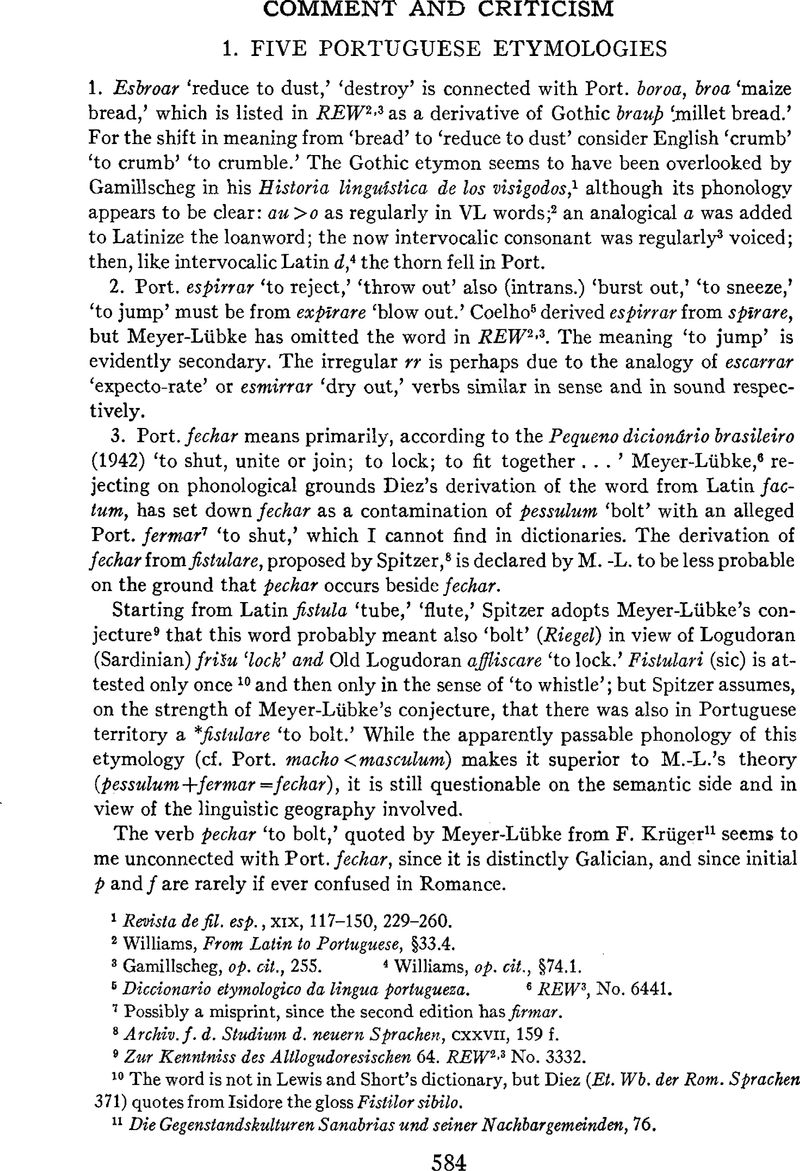No CrossRef data available.
Article contents
Five Portuguese Etymologies
Published online by Cambridge University Press: 02 December 2020
Abstract

- Type
- Comment and Criticism
- Information
- Copyright
- Copyright © Modern Language Association of America, 1946
References
1 Revista de fil. esp., xix, 117-150, 229-260.
2 Williams, From Latin to Portuguese, §33.4.
3 Gamillscheg, op. cit., 255.
4 Williams, op. cit., §74.1.
5 Diccionario etymologico da lingua portuguesa.
6 REW 3, No. 6441.
7 Possibly a misprint, since the second edition has firmar.
8 Archiv. f. d. Studium d. neuern Sprachen, cxxvii, 159 f.
9 Zur Kenntniss des Altlogudoresischen 64. REW 2,3 No. 3332.
10 The word is not in Lewis and Short's dictionary, but Diez (Et. Wb. der Rom. Sprachen 371) quotes from Isidore the gloss Fistilor sibilo.
11 Die Gegenstandskulturen Sanabrias und seiner Nachbar gemeinden, 76.
12 Op. cit.
13 Op. cit., §92.9, p. 97.
14 Rom. Gram., 2.611, §92.9.
15 Lang., xviii, 29.
16 Cf. Spitzer, Hisp. Rev., x, 344, who accepts the semantic shift ‘snarl’ > ‘gnaw’; questions the form ringari erroneously written by me for ClL ringi; questions the alleged Old Port, relhar quoted by me in reporting Prof. Holmes's theory deriving Port. rilhar from Lat. religare; and prefers to derive Port, rilhar from the already posited ∗ringulare ‘snarl.’ The Johns Hopkins professor here predicts that etymologists will soon be limiting their etymological bases to the types already recorded in REW 3. Cf. Rev. de fil. esp. 13.116, where Spitzer attempted to derive Sp. sesgar ‘to cut across’ from ∗sessicare ‘to set,’ instead of the ∗sesecare proposed by me and adopted in REW 3. I now recognize that Ulrich's etymon ∗sexicare (:∗sexus for sectus ‘cut’) is more probably correct, in view of Hispanic participles in -x- for -ct-: ∗dejexare > Sp. dejar, ∗coaxare > Sp. quejar (Hisp. Rev., vi, 351; ix, 309 f.), as well as Lat. fixus fictus, fluctus fiuxus, frixus frictus, etc. (Hisp. Rev. vi, 351). ∗Sexicare was first proposed in Z. f. rom. Phil., iv, 383.




